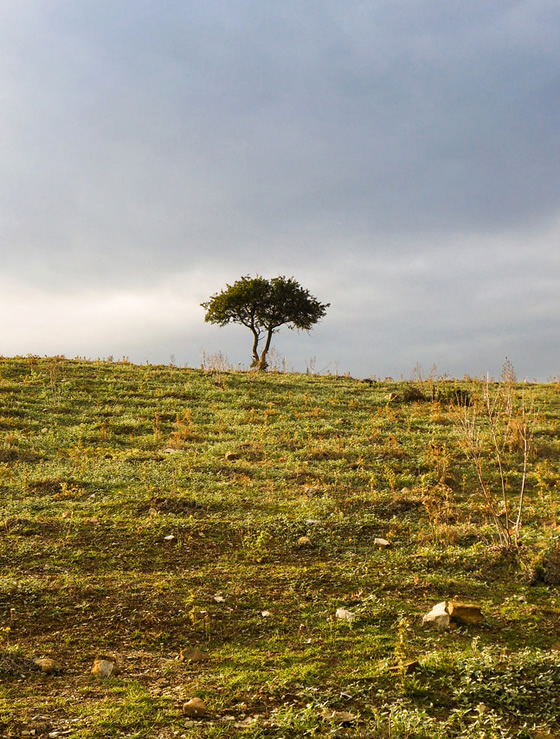 |
| Mediterranean Scrub |
Mediterranean scrub vegetation is dominated by fire-adapted shrubs. The biome fringes the Mediterranean Sea, for which it is named, but is also found along western coasts of continents in areas with warm, dry summers and moist, cool winters.
Regions with mediterranean vegetation are coastal regions between 30 and 45 degrees north latitude or between 30 and 45 degrees south latitude.
The air circulating around high-pressure zones over adjacent oceans guides storms away from the coast in the warm season but changes position in concert with the tilt of the earth on its axis and brings storms onto the coast in the cool season. As a result, the warm season is dry, and the cool season is moist. Fire is an important component of mediterranean environments, especially after the warm, dry summer.
  |
North America’s representative of mediterranean scrub is the chaparral of the Pacific Coast of Southern California and northern Baja California, Mexico. In chaparral and some other mediterranean regions, winds blowing from continental high-pressure regions toward the coast help push storm tracks offshore during the warm season.
In California these winds are called Santa Ana winds and are best known for driving chaparral fires. Lightning started such fires before human settlement, but they are often started by careless people today.
With the lower temperatures of autumn and winter the continental pressure wanes, and the Santa Ana winds decrease. At the same time, the oceanic high-pressure region shifts, and winter storms track onto the coast, bringing the cool season rains.
Character and Components
Mediterranean scrub is found in small, scattered areas around the world. The plant species that occur in this biome on one continent are unrelated to those that occur in the same biome on other continents.
As a result, mediterranean scrub presents a classical example of convergent evolution, the environmentally driven development of similar characteristics in unrelated species. Under the influence of mediterranean climate, entire communities of unrelated species become similar to one another. Many mediterranean areas also contain a large number of endemic plant species, species that grow nowhere else.
 |
| Character and component of Mediterranean scrub |
Mediterranean scrub is dominated by shrubs well adapted to fire. Some species have specialized underground structures that are undamaged by the fire and send up new growth shortly after the fire passes.
Other species have specialized, long-lived seeds that require intense heat to stimulate germination. Still other species combine the two strategies. In communities that burn regularly, such species have a great advantage over their competitors.
Mediterranean shrubs are not just adapted to recover after a fire; they are actually adapted to carry the fire once it is started. These species synthesize and store highly flammable chemicals in their leaves and stems. The flammable vegetation ensures that most fires will burn large areas.
   |
The most widespread shrub in North American chaparral is chamise (Adenostoma fasciculatum), which sprouts from underground structures and produces large numbers of seedlings after a fire.
Various species of manzanita (Arctostaphylos) and wild lilac (Ceanothus) are also wide spread throughout chaparral. Some species in each genus both sprout and produce large numbers of seedlings after fires. Other species in each genus depend entirely on heat-stimulated seeds to reestablish their presence in a burned area.
Mediterranean vegetation also occurs on western coasts in southern Australia, where it is called mallee; the Cape region of South Africa (fynbos); the central coast of Chile (matorral); and around the Mediterranean Sea (maquis).
In all these areas, the vegetation has the same adaptive characteristics and appearance, but the species are not related to those of other areas. Although there are differences among the regions besides the species that occur in each, the similar physical and vegetational characteristics lend a continuity that is widely recognized as the mediterranean scrub biome.
Concerns
 |
| Mediterranean scrub concern |
Second, fire suppression may actually increase fire damage and may threaten the mediterranean scrub biome’s very existence when combined with other human activities. Acomparison of the fire history in the chaparral of California and that of Baja California lends credibility to the idea that fire suppression increases fire damage.
Fire suppression has long been practiced in Southern California. In contrast,much less fire suppression has gone on in Baja. Fewer, larger, and more destructive fires burn in Southern California chaparral than in Baja chaparral.
The simplest explanation is that fire suppression allows fuel to build up, so that when a fire starts it is essentially unstoppable, as often occurs in California chaparral. With less fire suppression and less fuel accumulation, Baja fires burn more frequently but are smaller and less destructive. The small fires remove the fuel periodically, thus decreasing the danger of large, destructive fires.
There are other differences between California and Baja chaparral that may account for the differences in the fire regimes, but the foregoing hypothesis is interesting from the perspective of human impact on chaparral as well as that of fire’s impact on humans.
Population growth and its attendant activities threaten the very existence of the chaparral. Humans destroy chaparral to build home sites, suppress fires, and plant grass in burned areas to stabilize the soil and to mitigate future fires.
The grasses compete with chaparral plants and retard chaparral recovery. The impact of these and other activities on the native chaparral ecosystem is not well understood but is almost certainly negative. Other mediterranean scrub areas suffer similar fates.
Although mediterranean scrub is still well represented in comparison to some biomes, its response to human impact should be carefully studied and monitored, both to protect human investment inmediterranean ecosystems and to preserve the intriguing mediterranean scrub and its many unique plant species.
